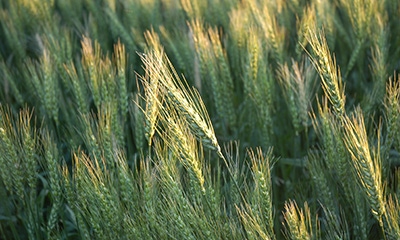January 12, 2016

Today's agriculture operates in a globalized world where something that happens in one region or country affects another.
One example is that of Argentina and its impending impacts on U.S. grain prices. According to the World Agricultural Supply and Demand Estimates from the USDA released Dec. 9, global wheat supplies for the 2015-2016 year have increased 2.3 million tons. This is primarily due to increased production but also higher beginning stocks. For this next year wheat trade is expected to increase 1.3 million tons because of larger supplies. A significant player in this market will be Argentina whose wheat exports are expected to grow by 1 million tons.

Wheat shimmers as the sun sets in this file photo. U.S. wheat will face new price pressure from Argentina.
This is not just explained by a great harvest in this South American country. The previous Argentinian government, which ended its mandate Dec. 9, had established what were called "retentions" to several of their exportable agricultural products. In essence, it was a pre-established percentage or tax, effective at the time of the sale that each farmer had to pay. The funds "retained" were incorporated to the national budget. Soybeans for example had 35% retention. Just imagine how much money 35% of the Argentinian soybean crop represented!
Farmers who sold grain in the international market did so at the world price minus these "government retentions." Not only was Argentina heavily taxing agriculture crops, but so was China and Russia. Russia, a world leader in wheat exports, has implemented a 40% retention.
In November, Argentina had national government elections and radically changed the direction of its economy.
One change announced by the new president was zero retentions for several agricultural exports. Government retentions up to that moment had been as follows: wheat, 23%; corn, 20%; sunflowers, 32%; and beef, 15%;. From now on, there will be zero retentions for all of them. The only exception is soybeans for which retentions will now be 30% rather than 35%.
If this new incentive to production is combined with the predicted $30-$40 dollar a barrel of crude oil for 2016 and beyond, it's not difficult to imagine what will happen to world agricultural production and prices. To make matters even worse, the Argentinian government has announced it will devalue its currency soon. This will further strengthen the U.S. dollar and make Argentina even more globally competitive.
Now, more than ever, U.S. farmers need to be extremely cautious with their cost of production. Significantly decreasing costs per acre during 2016 and beyond is going to be key to remain competitive and sustainable in this global market. For wheat, fertilizer and chemicals constitute half of the operating costs of production. These are two areas to focus on. Knowing exactly how much fertilizer your land needs, through soil testing and correcting accordingly, is going to be critical during 2016 to remain competitive. With the expansion of livestock operations, it also makes economic sense to look for partnerships and make use of livestock manure when feasible. Soil experts can help producers with guidelines to obtain an adequate, representative sample of the soil in which wheat is going to be planted.
Garcia is the South Dakota State University Extension Agriculture and Natural Resources Program Director
You May Also Like




